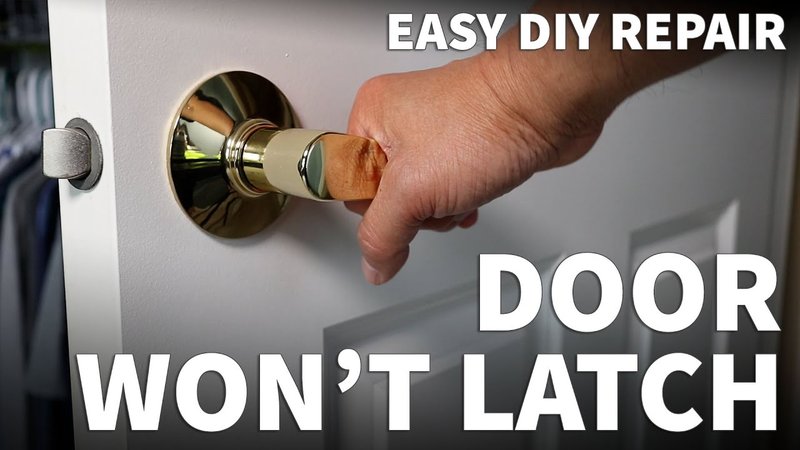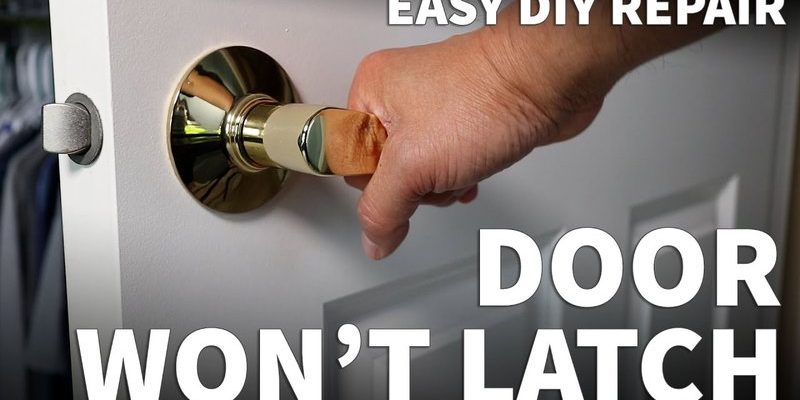
Plenty of folks assume a loose door just has a latch problem, maybe something a quick spray of WD-40 can fix. But honestly, there’s a whole world of reasons why your door can feel loose even when the latch, lock, or brand new Kwikset remote deadbolt looks—and sounds—completely fine. Sometimes, the answer hides in places you wouldn’t expect, like the subtle shift of a door frame or the compression of weatherstripping.
Let me walk you through what’s *really* happening when your exterior door feels loose, what might be to blame (beyond the latch), and what you can actually do about it—no matter the make or model of your door.
How a Properly Closed Exterior Door Should Feel
First, let’s talk about what you should expect from a well-fitted exterior door. When closed, a healthy door should feel snug and secure—no wiggling, rattling, or mysterious drafts. Think of closing a car door: You want that satisfying “thunk,” not a clunky rattle.
A tight seal does a couple of important things:
- Keeps out drafts and rain — Not just for comfort, but also for energy savings.
- Boosts home security — A snug door is harder to force open, even before you lock it.
- Reduces noise — A tight seal helps keep street sounds (and your neighbor’s leaf blower) outside where they belong.
If you’re feeling any movement in the door after it’s closed—whether it’s a side-to-side jiggle or a gentle push makes it flex inward—you’ve got a problem that goes deeper than the latch. Doors aren’t supposed to feel like flimsy remote covers or easily bent by hand.
The Door Frame: A Sneaky Source of Looseness
Here’s the thing—your exterior door is only as good as the frame it’s mounted in. Even the strongest, most secure door can feel loose if the frame has shifted or warped over time. Wood, for example, isn’t immune to the effects of changing humidity, temperature swings, or simple age.
A few ways a frame can cause trouble:
- Settling foundations: Houses naturally settle, sometimes causing the door frame to go out of square. Suddenly, the door doesn’t fit as tight as it once did.
- Warping: Exposure to rain or moisture can make sections of the frame swell, shrink, or twist. A frame that’s no longer perfectly straight means your door might close, but with an obvious looseness.
- Poor installation: If the frame was never installed square or level in the first place (happens more than you think), the door may have a permanent wiggle.
You might be wondering, how can you tell if your frame is the culprit? Try closing the door tight, then gently push or pull at the corners. If you hear a creak, see a gap, or feel movement, the frame might need some adjusting or even replacement. For doors controlled by smart locks or remotes (like a Schlage or Yale system), a misaligned frame can even stop the lock from syncing or pairing correctly.
Weatherstripping: The Silent Hero (or Villain)
Weatherstripping is that squishy material lining the edge of your door, meant to seal out air and water. But when it’s old, flattened, or missing sections, it can turn into the villain behind your loose door.
Here’s what tends to go wrong:
- Compression: Over years of use, weatherstripping gets squished down and loses its springy shape, leaving empty spaces between the door and the frame.
- Crumbling or cracking: Sun, cold, and constant use can make the material brittle, causing little chunks to break off and create gaps.
- Improper replacement: If you (or a previous owner) stuck on weatherstripping that’s too thin or thick, it might not fill the space properly, making the door feel loose even when closed.
Weatherstripping isn’t just a comfort feature; it’s a surprisingly big deal for security and energy use. If your exterior door feels loose, run your finger along the edge to check if the weatherstripping is worn out or missing. In some cases, upgrading to a better-fitting material is a quick, DIY fix that gives you that tight, satisfying seal again—no remote code or battery needed.
Hinges: More Than Just Screws and Pins
If your door feels loose, don’t overlook the hinges. They’re the unsung heroes that keep everything aligned and secure. But like anything mechanical, hinges can loosen, wear out, or even strip over time.
Here’s how hinges can cause a loose exterior door:
- Loose screws: If the screws have worked themselves loose, the entire door can shift within the frame—even if the latch is locked tight.
- Worn pin or barrel: Hinges have moving parts that can develop play (or slop) as they age. This play translates directly into door movement.
- Improper spacing: If hinges aren’t installed at the right intervals or are bent out of shape, the door might not fit squarely, leaving room for that annoying jiggle.
Want to check your hinges? With the door open, wiggle it up and down or side to side. If you see the entire door moving at the hinge side, grab a screwdriver and tighten any loose screws. For stripped holes, you might need to fill them with wood glue and toothpicks before re-screwing. For tenants or those who prefer hands-off fixes, calling a pro for a reset or hinge swap on your Andersen or Therma-Tru door can make a world of difference.
Door Slab Warping and Material Issues
Sometimes, the problem isn’t the frame or the hardware—it’s the door itself. Most exterior doors are either wood, steel, or fiberglass, and each has its own quirks when it comes to warping or distortion.
Let me explain what can happen:
- Wood doors: Beautiful, but they’re notorious for swelling in humid weather and shrinking in the cold. Over time, this movement can twist or bow the door, making it impossible to sit flush against the weatherstripping or frame.
- Steel doors: More stable, but can dent (especially in homes with kids or if you sometimes use your hip as a “remote” to close them). Dented doors often lose their close fit.
- Fiberglass doors: Durable and energy-efficient, but if installed poorly, even these can warp or develop gaps, especially after years of sun exposure.
A warped or bowed door won’t just feel loose; you might notice it sticks in some places and wobbles in others. Sometimes, a simple adjustment can fix the problem, but in more serious cases, you might need to replace the door slab itself. Honestly, even the fanciest smart lock system can’t sync a door that’s no longer square.
Threshold and Sill Problems
Down at the bottom of your door, the *threshold* (or sill) plays a more important role than you might think. It’s the piece your door “lands” on when closed, and if it’s worn out, cracked, or misaligned, your door can feel loose or fail to make solid contact.
Common problems include:
- Worn or damaged threshold: Years of foot traffic, water, or shifting house foundations can cause the threshold to sink, crack, or tilt.
- Poor adjustment: Many modern thresholds can be raised or lowered for a snug fit. If left too low, the door simply can’t meet it properly—even with perfect latches and weatherstripping.
- Gaps: If you see daylight under your door or feel a draft, your threshold is probably part of the looseness issue.
If you’ve never adjusted a threshold before, check for little screws or caps along the sill. Most newer doors (including big brands like Masonite or Pella) let you tweak the height with a screwdriver. Small fixes here can make a huge difference in getting that firm, lock-in-place feeling.
How Home Security Is Affected by a Loose Door
A loose exterior door isn’t just a minor annoyance—it’s a real security risk. Even with a top-tier smart lock, deadbolt, or code-based remote lock (like August or Yale), a door that moves or wiggles can be easier to force open.
Here’s why it matters:
- Less resistance to kick-ins: Gaps and looseness mean parts of the door and frame aren’t supporting each other, making it easier for someone to break in.
- Lock failures: If the door isn’t lined up right, remote or battery-powered locks may not even engage properly.
- Easy to “jimmy”: Thieves can exploit even tiny gaps around a loose door with simple tools.
In short, a secure home starts with a snug-fitting door. If yours feels loose when closed, don’t ignore it—even if everything else seems to be working fine.
Troubleshooting and Fixes for a Loose Exterior Door
So, what can you actually do if your exterior door feels loose when closed? Here’s a simple troubleshooting roadmap:
Always start with the easiest fixes and work your way up. Sometimes, a loose screw or a ten-dollar pack of weatherstripping can save you from a major repair.
- Tighten all hinge screws—on both the door and frame.
- Check and replace weatherstripping if it’s flat, crumbling, or missing.
- Inspect the door slab and frame for signs of warping or twisting.
- Adjust the threshold for a better seal at the bottom.
- Look for frame gaps—if you spot any, caulking or a more involved repair might be needed.
- Check your lock hardware (especially for smart locks): Make sure everything syncs, resets, and pairs as it should. Misalignment can stop a remote or code-based system from working at all.
If nothing works and your door still feels loose—even after all the tweaks—it might be time for professional help or even a new door and frame. Modern doors, especially those with remote-operated locks or advanced battery-powered security, need tight tolerances to function properly.
When to Call a Pro (And Why It’s Sometimes Worth It)
There’s no shame in calling a pro if your door just won’t cooperate. DIY fixes can go a long way, but serious frame shifts, heavy warping, or persistent threshold problems often need more than a screwdriver and good intentions.
Reasons to get a professional involved:
- Persistent looseness after all basic fixes
- Visible warping or frame separation
- Issues with advanced locking systems (like remotes, keypads, or battery-backed deadbolts) that you can’t sync, reset, or pair after fixing the door alignment
An experienced contractor can reset a frame, swap out a warped slab, or diagnose issues you might have missed, saving you countless hours of frustration. And honestly, when it comes to home security and comfort, that peace of mind is usually worth it.
Closing Thoughts: A Snug Door Is a Happy Door (and Owner)
A loose exterior door—no matter the brand, material, or lock type—can turn a simple part of daily life into a source of annoyance or worry. Whether you’re dealing with a high-tech smart lock, a trusty old deadbolt, or a remote-controlled keypad, the fit and feel of your door matter far more than most people think.
The next time your door closes with a disappointing wobble, remember: It’s rarely *just* the latch. From sneaky frame shifts to sad, squished weatherstripping, there are lots of reasons for that loose feeling—and just as many solutions. Don’t ignore it. With a little troubleshooting and the right fix (or help from a pro), you can get that satisfying, secure “click” every time—and enjoy a more peaceful, comfortable, and secure home.
